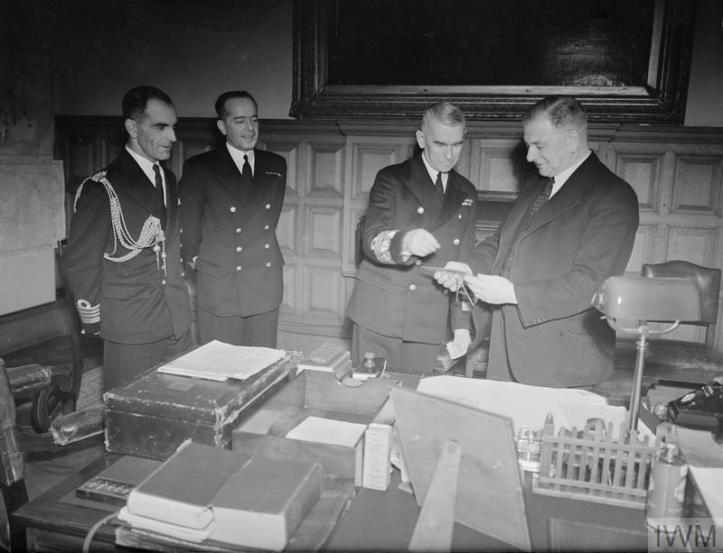
51 New Cavendish Street, W1 is a rather unassuming building in the heart of the West End, surrounded by the medical practices that sprawl around Harley Street. During the Second World War, however, it was home to Polish Naval Headquarters, commanding the Free Polish navy.[1] This organisation is rather overshadowed nowadays by the memory of Poland’s air and ground forces in exile, but has an interesting history in its own right.
Polish navy in Britain
The Polish navy came into being in November 1918, largely to assert the sovereignty of the new Polish state over the Pomeranian coast.[2] Its rights over this 90-mile coastline were eventually recognised in February 1920. The region’s main port, Danzig, remained tantalisingly out of reach and became an independent ‘free state’, forcing the Polish navy to set up in nearby Gdynia.
Despite this early setback, Poland adopted wildly ambitious plans for its navy in the first years of its independence. Initial enthusiasm for naval expansion culminated in an astonishing declaration in 1920 when the Government announced its intention to create a vast fleet that would have included two battleships, six cruisers, and 28 destroyers. This was abandoned almost immediately for cost reasons. However, some new warships were indeed ordered from France and the Netherlands over following years, included some funded by public subscription. By September 1939, the Polish navy could nonetheless boast of a respectable complement of four destroyers and five submarines, as well as a handful of smaller vessels.
There was nonetheless no doubt that the Polish navy would be unable to prevent German domination of the Baltic, were an invasion to occur. On 29 August 1939, just days before the German invasion, three Polish destroyers were ordered to leave for British waters in a plan known as Operation Peking. Though reluctant to abandon such a large proportion of its naval assets, the Polish Government imagined that their forces would retreat southwards towards the so-called Romanian Bridgehead, abandoning the coastline anyway. This turned out to be very sensible. The remaining destroyer in Polish waters was sunk on the third day of fighting and much of the rest of the remaining surface fleet was annihilated by German aircraft shortly afterwards. Two submarines, including the Orzel which escaped from internment in neutral Estonia, were also able to escape to the United Kingdom where the Polish Navy was able to survive under British auspices, joined by 38 civilian ships from the Polish Merchant Navy.
Consolidation in London
With five vessels of its own, the Polish Naval Detachment in Great Britain was created by an agreement between the Polish Ambassador and the Foreign Office on 18 November 1939. After a brief spell in Paris, its staff set up in London in December 1939. Under the agreement, the Poles retained administrative control over their ships but were forced to submit to British operational command.
Militarily, the Polish Navy remained extremely dependent on the Royal Navy. This was particularly true as its ranks thinned. It suffered a string of catastrophes in 1940 when a destroyer and submarine were sunk in action, leaving it with just three ships. However, these were soon replaced by vessels seized from the French and Belgian navies after the defeat. They also received British vessels too. During the course of the war, the Poles would receive six destroyers from the British. Indeed, a long-term naval ambition was realised in January 1943 when the British handed over a cruiser, the Dragon. From around 1,000 men in Britain in 1939, the Free Polish navy would expand to about 4,000 men by the end of the war.

Notwithstanding its relatively small size, the Polish Navy was not immune from political infighting. It was initially commanded by Vice-Admiral Jerzy Świrski, a respected naval commander who had begun his career decades earlier in the Imperial Russian Navy. Świrski had commanded the Polish Navy since 1922 and masterminded many of the ambitious pre-war plans but soon came into conflict with his superior, General Władysław Sikorski.
The dispute apparently originated around a conflict on the submarine Wilk whose commander committed suicide in 1941. Angry, Sikorski dismissed Świrski and promoted another officer, Commander Tadeusz Morgenstern-Podjazd[3], in his place. Świrski, for his part, appealed to the British. Though probably outraged at this humiliation, Sikorski was forced to back down.[4]
It seems probable that these conflicts were played out in or around the Polish Navy’s Headquarters in New Cavendish Street, just a few streets away from the Polish Embassy.
Service
Despite its internal difficulties, the Free Polish navy made a gallant contribution to the Allied war effort at sea, especially during the Battle of the Atlantic. This was not without cost. It lost five warships during the period and some 404 men. In one example, the Orkan, a modern destroyer, was torpedoed by a U-Boat in October 1943 with the loss of 175 lives. The cruiser Dragon would itself fall victim to a torpedo in July 1944 while supporting the Normandy Landings.
The defeat of Germany meant the force’s days were numbered, however. On 24 September 1946, the Polish Naval Detachment in Great Britain was formally abolished at a ceremony in Rosyth. Most of its warships were returned to the Royal Navy. The Błyskawica, one of the original Polish destroyers from 1939, survived the conflict and was returned to Gdynia where it remains today as a museum ship. Nonetheless, the general feeling among its personnel was not sympathetic to Poland’s new communist government. As Janina Doroszkowska, the daughter of the Błyskawica’s captain, recalled:
We were all devastated that we had seemingly won the war but lost our country! It was a black time indeed. The worst day of all was the day father had to hand over ‘his’ beloved ORP Błyskawica to the Royal Navy who, he knew, would then hand her on to the Communist government in Poland. The grief of my parents, the poignancy and the completely funereal atmosphere of that day will stay with me as the worst day of my life.[5]
Similar views were shared by many Polish exiles in Britain, but a particularly large number of naval personnel do seem to have chosen to remain in the United Kingdom rather than chose repatriation. Among them were Świrski and Morgenstern-Podjazd, who would both die in London in 1959 and 1973 respectively.
[1] Contemporary documents seem to give the address as 28 Wimpole Street…
[2] Much of the information on the pre-war Polish navy comes from an excellent summary article: ‘The Polish Navy in WW2’, Naval-encyclopedia.com (5 Dec. 2018).
[3] Morgenstern-Podjazd’s experience in the Polish Navy was almost as long as Świrski’s. Having begun his career in the Austria-Hungarian Navy, he rose through the ranks and gained particular favour with the dictator Marshal Józef Piłsudski in the 1930s.
[4] ‘Jerzy Świrski – kontrowersyjny admirał’, Polskie Radio, 12 June 2018.
[5] ‘Wojciech Francki, Commander’, Polish Naval Memories of World War II (Kresy-Siberia Foundation), nd.
There is another story about 51 New Cavendish Street which is altogether more bizarre. The naval plaque which currently marks the site was the result of a campaign in 2013 led by an Anglo-Polish charity worker and educationalist named Philip Bujak. A respected public figure and noted campaigner for Montessori schools, Bujak was convicted in 2018 of defrauding his charity to the tune of £180,000 and sentenced to six years’ imprisonment…